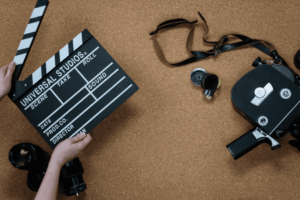Sound blankets are materials worth spending that decrease the noise and sound around you. Known as sound dampening or sound deadening, you can use these blankets at home, in board rooms, auditoriums, and studios while podcasting, recording, and shooting movies to filter, block, or absorb noises.
Sound blankets can be the best choice when you encounter circumstances to prevent your location from environmental noise or noise leakage from your place. However, whatever you choose, you must never forget to consider the cost. In this way, a sound blanket is the most beneficial and cost-effective tool. Therefore, this article outlines sound blanket’s importance and benefits and suggests some of the best sound blankets available.
What is a Sound Blanket?
Unlike a traditional blanket, a sound blanket is a material that reduces the external noise within a room. Alternatively, It is also known as acoustic wraps, noise blankets, and noise covers. You can cover your floors, walls, or ceilings with these blankets to prevent unwanted noise in your room. Further, you can customize it as per your requirement or opt for a universally available size. However, the amount of noise control depends on:
- The type of material used to make the blanket
- The volume of noise
- Type of noise
- The thickness of the blanket
- The way the blanket is stitched
- Blocking the number of air gaps

Best Soundproof Blankets You Can Buy






Are Sound Blankets Worth It?
Sound blankets are famous for blocking noise; you cannot expect them to eliminate noise. However, these blankets show a 30-80% noise reduction capacity. To achieve the best results, you must seal all the air gaps through your doorways with a soundproof curtain. For this purpose, choose a curtain whose length is more than 5 cm of your doorway’s length on both sides. Despite their controlled ability to block sounds, sound blankets are a popular sound control medium for the following reasons:
Zero Installation
The popularity of sound control blankets is because it doesn’t require any installation process. You can wrap it around any area you want to control sound. Therefore, it is less time-consuming and saves a lot of space.

Versatile
Once you buy a soundproof blanket, you can use it whenever and wherever you want at your convenience, which makes it versatile.

Mobile
Sound blankets are a savior when you want to soundproof an area in a remote location. This is because constructing a soundproof structure may be difficult and time-consuming.
Cost-Effective
Thirdly, sound blankets are pretty inexpensive, especially when ordered in bulk. In addition, they are easily portable and hence can be carried over anywhere for use. Therefore, a couple of blankets that you carry will make a huge difference financially.
Suits the Surroundings
The presence of soundproofing blankets is almost invisible as they blend into the scene where you use them. Hence, you don’t need a way to hide their existence. Additionally, they are available in various colors and designs, which makes them aesthetically pleasing.
When to Use a Sound Blanket?
Apart from knowing the advantages, you must know when to use the sound blanket to derive the maximum benefits.
You require a reliable sound dampening over:
- Doors
- Ceilings
- Floors
- Walls
- Around appliances
- Bedrooms
- Bathrooms
- Laundry rooms
- Garages
Your place has a lot of hard surfaces with minimal furniture. Furniture generally absorbs noise.
Where to Use Sound Blankets?
You can use soundproof blankets for a variety of reasons, some of which are given below:
Studios
Vocalists and Studio Professionals look for ways to kill the echo reverberating in their recording space. Sound blankets are beneficial in such cases as they cancel out the echo. Additionally, you can make your DIY vocal booth with these blankets and some basic carpentry skills.

Music Rooms
Musicians often practice their instruments within their rooms. But their practicing schedule may not synchronize well with a fellow neighbor. Consequently, they will seek to control their music within the premises of their room. In such cases, you can hang a sound blanket around the room to stop the music from leaking away into the environment.

Industrial Applications
Industries use heavy machinery that emanates a more significant amount of noise. Hence, these blankets are often used around generators, compressors, and appliances to prevent noise leakage.
Gymnasiums
Gymnasiums feature noisy equipment. Additionally, they contain harsh surfaces that bounce back the noise and enhance it within the room. You can quickly dampen sharp noises in such locations with a soundproof blanket.
How Do Sound Blankets Work?
Soundproofing blankets consist of multiple layers. However, the outer layer constitutes the woven fabric. This layer allows the sound waves to pass through it. Consequently, the sound waves reach the inner layers. The inner layers have common sound insulation fiber materials like recycled cotton, fiberglass, mineral wool, and mass-loaded vinyl. The thickness of this inner layer decides the amount of sound absorbed.
In addition, these blankets come with the provision of grommets. With the help of grommets, you can hang the blankets onto the walls. This facilitates you to create a portable sound barrier or vocal booth.
Things To Consider
The density of the outer layer
Your blanket should consist of a thick, dense outer fabric. This is because the lighter woven fabrics are not suitable for soundproofing. In this sense, you can prefer blankets whose outer layers are cotton or polyester. In addition, the density of the weave is the most determining factor compared to the fabric type used.
The material of the inner layer
The inner layer of a soundproof blanket absorbs and blocks the sound. Based on your user needs, you can opt for a blanket made of a specific inner layer. Two types of inner layer material have a particular purpose. They include:
| Requirement | Type Of Material |
| To block the sound from an external environment | MLV or Mass-Loaded Vinyl |
| To absorb the sound within a room have a clear audio | Mineral wool, fiberglass, cellulose, and foam |
You need to know if you want to block the external noise or if you want to cancel the noise in your room.
Mass Loaded Vinyl (MLV)
Mass-loaded vinyl is an effective soundproofing solution. It packs a dense amount of vinyl in a relatively thinner sheet, making it an effective barrier suitable for a quieter home and work environment. In addition, when sound waves strike against MLV, they get absorbed. Consequently, the energy in sound waves is drastically reduced. Available in multiple weights and thicknesses, this material diminishes sound vibrations and noise through wall and ceiling linings.
Measure the sound reduction of blankets
If you are opting for a professional soundproof blanket, they include the standard soundproofing measurements such as :
Noise Reduction Coefficient (NRC)
This parameter tells the amount of sound a material absorbs at wavelengths between 250 Hz and 2000 Hz. Hence, it is used for blankets using sound-absorbing material like foam. For example, a material with an NRC rating of 0.75 is considered highly absorptive. 0.75 NRC means it absorbs 75% of passing sound waves.
Sound Transmission Class (STC)
This parameter tells the amount of sound a material blocks. Hence it is used for blankets containing MLV. You can prefer materials with an STC rating of 40 or more. However, if you are using a moving blanket, you can consider the type of material, weight, and thickness to know its sound absorbency.
Ease of Use
Some sound blankets are challenging to use as you must hang them on the curtain rods with heavy-duty hooks. Hence, choose blankets that come with a grommet provision.
Cost of Sound blankets
The cost of your sound blankets depends upon the materials used and their size. An efficient industrial soundproof blanket may cost you up to $400. If you find it challenging your budget, you may opt for moving blankets because:
- They prevent sound due to their thickness and density.
- They cost less than $50.
- They come with grommets. Alternatively, you can sew a rail to your soundproof door curtain, allowing you to hang some hooks.
Final Thoughts
Sound blankets are the best choice for downsizing noise or sound. They are portable, devoid of installation cost, and versatile, which makes them a popular choice. However, you need to choose the right one based on the type of material it comprises, its cost, and ease of use.
Sound Blankets: Videos
Reduce Echo and Reverb with Sound Blankets
Acoustic Panels vs Moving Blankets: Is There a Difference?
Acoustic Blankets for Set or Studio














